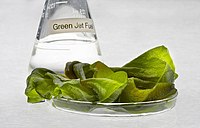
Photo from wikipedia
Abstract Post-extraction algal residue (PEAR), the co-product of algal biofuel production, has potential to be incorporated as an ingredient in ruminant diets. Market value of PEAR will be driven by… Click to show full abstract
Abstract Post-extraction algal residue (PEAR), the co-product of algal biofuel production, has potential to be incorporated as an ingredient in ruminant diets. Market value of PEAR will be driven by its ability to compete with commonly fed protein sources, such as cottonseed meal (CSM) and dried distillers’ grains (DDG). Two experiments were conducted to evaluate the potential for PEAR to be incorporated in existing protein supplementation strategies of the beef industry. In Experiment 1, 12 steers were used in a 12 × 12 Latin square experiment consisting of 12, 4-d periods to evaluate the palatability of PEAR at divergent inclusion levels and with differing carriers (DDG; CSM; liquid supplement, LS) as a supplement to cattle consuming a basal diet of Bermudagrass hay. Each period included 3-d where steers were fed a test supplement followed by a 1-d washout where steers were fed DDG. Blends were formulated with carrier ingredients (CSM, DDG, or liquid supplement, LS) at varying levels of PEAR inclusion; PEAR and carrier ingredients were also offered as stand-alone supplements. Completion rate and consumption rate (g supplement consumed/min) were recorded daily. In Experiment 2, six steers were used in concurrent 3 × 3 Latin Square experiments to determine the effect of PEAR on nutrient utilization and mineral intake in steers consuming low-quality forage. Treatments included no supplemental protein (CON) and isonitrogenous levels of PEAR or CSM (100 mg N/kg BW). In Experiment 1, completion rate was ≥90 % for DDG- and CSM-based blends, which was greater (P
Journal Title: Animal Feed Science and Technology
Year Published: 2021
Link to full text (if available)
Share on Social Media: Sign Up to like & get
recommendations!